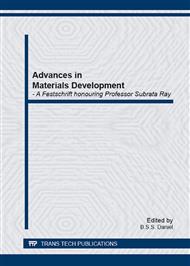[1]
M. Winter, J. O. Besenhard, M. E. Spahr and Petr Novak, Insertion electrode materials for rechargeable lithium batteries, Adv. Mater. 10 (1998) 725-763.
DOI: 10.1002/(sici)1521-4095(199807)10:10<725::aid-adma725>3.0.co;2-z
Google Scholar
[2]
A. N. Dey, Electrochemical Alloying of lithium in organic electrolytes, J. Electrochem. Soc. 118 (1971) 1547-1549.
DOI: 10.1149/1.2407783
Google Scholar
[3]
I. A. Courtney and J. R. Dahn, Electrochemical and In situ X-Ray diffraction studies of the reaction of lithium with tin oxide composites, J. Electrochem. Soc., 144 (1997) 2045-(2052).
DOI: 10.1149/1.1837740
Google Scholar
[4]
R. A. Huggins, Materials science principles related to alloys of potential use in rechargeable lithium cells, J. Power Sources, 26 (1989) 109-120.
DOI: 10.1016/0378-7753(89)80020-5
Google Scholar
[5]
A. S. Baranski and W. R. Fawcett, The formation of lithium-aluminum alloys at an aluminum electrode in propylene carbonate, J. Electrochem. Soc. 129 (1982) 901-907.
DOI: 10.1149/1.2124050
Google Scholar
[6]
W-J Zhang, A review of the elctrochemical performance of alloy anodes for lithium- ion batteries, J. Power Sources, 196 (2011) 13-24.
Google Scholar
[7]
H. Li, L. Shi, W. Lu, X. Huang and L. Chen, Studies on capacity loss and capacity fading of nanosized SnSb alloys anode for Li-Ion batteries. J. Electrochem. Soc. 148 (2001) A915-A922.
DOI: 10.1149/1.1383070
Google Scholar
[8]
H. Kim, J. Choi, H. J. Sohn, T. Kang, The insertion mechanism of lithium into Mg2Si anode materials for Li-Ion batteries, J. Electrochem. Soc. 146 (1999) 4401-4405.
DOI: 10.1149/1.1392650
Google Scholar
[9]
Y. Idot, T. Kubota, A. Matsufuji, Y. Maekawa and T. Miyasaka, Tin-based amorphous oxide: a high capacity lithium-ion storage materials, Science 276 (1997)13951397.
DOI: 10.1126/science.276.5317.1395
Google Scholar
[10]
J. Yang, M. Winter and J. O. Besenhard, Small particle size multiphase Li-alloy anodes for lithium-ion batteries, Solid State Ionics 90 (1996) 281-287.
DOI: 10.1016/s0167-2738(96)00389-x
Google Scholar
[11]
M. D. Fleischauer, M. N. Obrovac, J. D. McGraw, R. A. Dunlap, J. M. Topple and J. R. Dahn, Al-M (M=Cr, Fe, Mn, Ni) thin film negative electrode materials, J. Electrochem. Soc. 153 (2006) A484-A491.
DOI: 10.1149/1.2161569
Google Scholar
[12]
J. Yang, Y. Takeda, N. Imanishi and O. Yamamoto, Ultrafine Sn and SnSb0. 14 powders for lithium storage matrices in lithium-Ion batteries. J. Electrochem. Soc. 146 (1999) 4009-4013.
DOI: 10.1149/1.1392584
Google Scholar
[13]
J. Yang, M. Wachtler, M. Winter and J.O. Besenhard, Sub-microcrystalline Sn and Sn-SnSb powders as lithium storage materials for lithium-Ion batteries, Electrochem. Solid-State Lett. 2 (1999) 161-163.
DOI: 10.1149/1.1390769
Google Scholar
[14]
C. M. Park and H. J. Sohn, Electrochemical characteristics of TiSb2 and Sb/TiC/C nanocomposites as anodes for rechargeable Li-Ion batteries. J. Electrochem. Soc. 157 (2010) A46-A49.
DOI: 10.1149/1.3254161
Google Scholar
[15]
Y. Liu, Z. Y. Wen, X. Y. Wang, X. L. Yang, A. Hiranoc, N. Imanishic and Y. Takeda, J. Improvement of cycling stability of Si by mechnochemical reduction and carbon coating, Power Sources 189 (2009) 480-484.
DOI: 10.1016/j.jpowsour.2008.12.045
Google Scholar
[16]
C. Park, Y. U. Kim, H. Kim and H. J. Sohn, Enhancement of the rate capability and cyclability of an Mg-C composite electrode for Li secondary batteries, J. Power Sources 158 (2006) 1451-1455.
DOI: 10.1016/j.jpowsour.2005.10.017
Google Scholar
[17]
L. Z. Zhao, S. J. Hu, Q. Ru, W.S. Li, X.H. Hou, R.H. Zheng and D.S. Lu, Effects of graphite on electrochemical performance of Sn/C composite thin film anodes, J. Power Sources 184 (2008) 481-484.
DOI: 10.1016/j.jpowsour.2008.04.074
Google Scholar
[18]
J. Hassoun, A. Fernicola, M.A. Navarra, S. Panero and B. Scrosati, An advanced lithium-ion battery based on a nanostructured Sn-C anode and an electrochemically stable LiTFSi-Py24TFSI ionic liquid electrolyte, J. Power Sources 195 (2010) 574-579.
DOI: 10.1016/j.jpowsour.2009.07.046
Google Scholar
[19]
D. Deng and J. Y. Lee, Reversible storage of lithium in a Rambutan-like tin-carbon electrode Angew. Chem. Int. Ed. 48 (2009) 1660-1663.
DOI: 10.1002/anie.200803420
Google Scholar
[20]
A. Aboulaich, M. Mouyane, F. Robert, P. -E. Lippens, J. Olivier-Fourcade, P. Willmann and J. -C. Jumas New Sn-based composites as anode materials for Li-ion batteries, J. Power Sources 174 (2007) 1224-1228.
DOI: 10.1016/j.jpowsour.2007.06.173
Google Scholar


